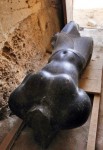 An Egyptian-Dominican team of archaeologists excavating the site of Taposiris Magna, a limestone temple 30 miles west of Alexandria which is a leading candidate for the burial location of Cleopatra and Marc Antony, have uncovered a huge headless statue and an original temple gate.
An Egyptian-Dominican team of archaeologists excavating the site of Taposiris Magna, a limestone temple 30 miles west of Alexandria which is a leading candidate for the burial location of Cleopatra and Marc Antony, have uncovered a huge headless statue and an original temple gate.
The 2000-year-old statue is a very well preserved figure wearing the traditional collar and kilt of the Egyptian pharaoh. Zahi Hawass suspects it may be a representation of Ptolemy IV, the pharaoh who constructed the Taposiris Magna temple.
The joint Egyptian-Dominican team working at Taposiris Magna discovered the temple’s original gate on its western side. In pharaonic Egypt the temple was named Per-Usir, meaning ‘A place of Osiris’. Legend has it that when the god Seth killed Osiris he cut him into fourteen pieces and threw them all over Egypt. This is one of fourteen temples said to contain one piece of the god’s body.
The team also found limestone foundation stones, which would once have lined the entrance to the temple. One of these bears traces indicating that the entrance was lined with a series of Sphinx statues similar to those of the pharaonic era.
The team has spent five years excavating Taposiris Magna for the burial site of Antony and Cleopatra. They’ve found many other headless royal statues, possibly decapitated during the Byzantine and Christian eras, plus collections of Cleopatra heads and coins. They also found a necropolis of Greco-Roman mummies buried facing the temple, indicating that someone of royal status was buried in the temple of Osiris.
Hawass thinks these are signs that Antony and Cleopatra could be buried there rather than at Cleopatra’s palace in Alexandria, which is now underwater. Even if that turns out to be a pipe dream, however, the discoveries at Taposiris Magna are important in their own right.
I can’t remember, why don’t we know where she’s buried? I feel like that’s something the Roman’s would have kept tabs on.
What I’d really like to know is what does a piece of Osiris LOOk like?
And which piece are we talking about. *snicker*
We don’t know where she’s buried because Ptolemaic Alexandria is under water. Contemporary sources suggest she and Antony were laid to rest in her mausoleum which was adjacent to her palace. Both of them fell into the sea courtesy of earthquakes and tsunamis.
Hawass thinks she might have been buried elsewhere, however. Why, I don’t know. Wishful thinking? PR value? Some actual evidence? Boh.